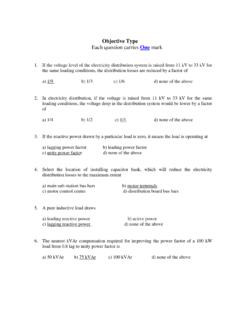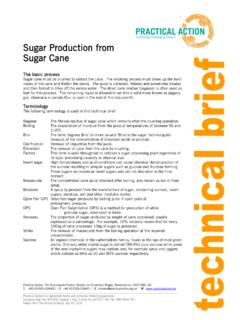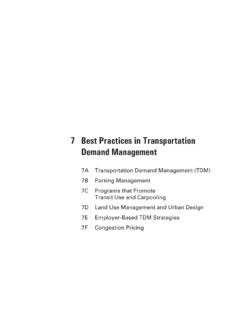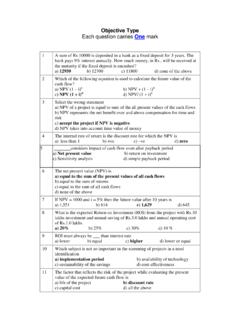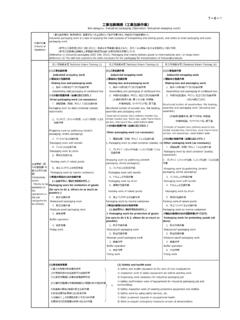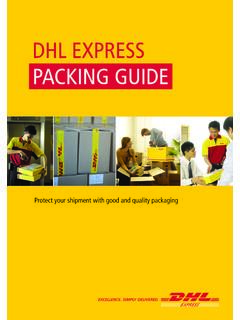Transcription of Packaging Materials for Foods - CTCN
1 Practical Action, The Schumacher Centre, Bourton on Dunsmore, Rugby, Warwickshire, CV23 9QZ, UK T +44 (0)1926 634400 | F +44 (0)1926 634401 | E | W _____ Practical Action is a registered charity and company limited by guarantee. Company Reg. No. 871954, England | Reg. Charity | VAT No. 880 9924 76 | Patron HRH The Prince of Wales, KG, KT, GCB Packaging Materials for Foods Introduction This Technical Brief describes the technical properties of different food Packaging Materials . For more detailed information on Packaging using glass containers see Technical Brief: Packaging Foods in glass, and for methods of filling and sealing containers, see Technical Brief: Filling and Sealing Packaged Foods .
2 The technical purposes of Packaging are: To contain Foods (to hold the contents and keep them clean and secure without leakage or breakage until they are used). To protect Foods against a range of hazards during distribution and storage (to provide a barrier to dirt, micro-organisms and other contaminants, and protection against damage caused by insects, birds and rodents, heat, oxidation, and moisture pickup or loss). To give convenient handling throughout the production, storage and distribution system, including easy opening, dispensing and re-sealing, and being suitable for easy disposal, recycling or re-use. To enable the consumer to identify the food, and give instructions so that the food is stored and used correctly.
3 The shelf life of a food is the length of time it can be stored before the quality becomes unacceptable, and this includes the time to distribute food to retailers and store it by the consumer. It is important to note that the selection of a Packaging material for a particular food depends not only on its technical suitability ( how well the package protects a food for the required shelf life), but also on the availability and cost in a particular area, and any marketing considerations that favour choosing a certain type of package. Packaging is important because it aids food distribution, and rapid and reliable distribution helps remove local food surpluses, allows consumers more choice in the Foods available and helps to reduce malnutrition.
4 Packaging also reduces post harvest losses, which together with giving access to larger markets, allows producers to increase their incomes. Therefore, adequate Packaging in developing countries has profound effects on both the pattern of food consumption and the amount of food consumed. Packaging Materials can be grouped into two main types: 1. Shipping containers, which contain and protect the contents during transport and distribution but have no marketing function. Examples include sacks, corrugated fibreboard (cardboard) cartons, shrink -wrapped or stretch -wrapped containers, crates, barrels or drums. Fig 1: Polypropylene drums used as shipping containers for fruit pulp (Photo: Peter Fellows) Packaging Materials for Foods Practical Action 2 2.
5 Retail containers, which protect and advertise the food for retail sale and home storage. Examples include metal cans, glass or plastic bottles and jars, plastic tubs, pots and trays, collapsible tubes, paperboard cartons and flexible plastic or paper bags, sachets and overwraps. Frequently more than one type of material is used to package a single product. For example, display cartons may contain multiple packs of food packaged in flexible film. These in turn are placed in corrugated board shipping boxes and loaded onto pallets. Types of Packaging Materials - traditional Materials These Materials have been used since the earliest times for domestic storage and local sales of Foods .
6 However, with the exception of glazed pottery, they have poor barrier properties and are only used to contain Foods and keep them clean. They are also unsuited to the needs of commercial production processes and are considered by many customers to be less attractive than the newer industrial Materials described below. A summary of the main types of traditional Materials and possible current uses are as follows: Leaves, vegetable fibres and textiles Leaves are cheap and readily available, and are used as wrappers for products such as cooked Foods that are quickly consumed. Banana or plantain leaves are used for wrapping traditional cheese and fruit confectionery such as guava cheese.
7 Maize leaves are used to wrap corn paste or blocks of brown sugar, and 'Pan' leaves are used for wrapping spices in India. Other examples are green coconut palm, papyrus leaves and bamboo and rattan fibres, which are woven into bags or baskets and used for carrying meat and vegetables in many parts of the world. Palmyra palm leaves are used to weave boxes in which cooked Foods are transported, and small banana leaf bags are used to contain coffee beans (Fig. 1) that are a traditional gift in some parts of Africa. Some of these have the potential to be developed as niche packaged products for tourist markets. Fibres from kenaf and sisal plants are mainly used for making ropes, cord and string, which can be made into net bags to transport hard fruits.
8 They can also be spun into a yarn that is fine enough to make coarse canvas. Other examples of textile containers are woven jute sacks, which are used to transport a wide variety of bulk Foods including grain, flour, sugar and salt. Plant fibre sacks are flexible, lightweight and resistant to tearing, have good durability, and may be chemically treated to prevent them rotting. Their rough surfaces are non-slip, which makes stacking easier compared to synthetic fibre sacks, and they are bio-degradable. Most textile sacks can be re-used several times after washing and they are easily marked to indicate the contents. They are still widely used to transport fresh or dried crops, but they are being replaced as shipping containers by woven polypropylene or multi-walled paper sacks (below).
9 Calico is a closely woven, strong cotton fabric that can be made into bags for flour, grains, legumes, coffee beans and sugar. Methods of filling and sealing sacks and bags are described in Technical Brief: Filling and Sealing Packaged Foods . Muslin and cheesecloth are open-mesh, light fabrics used both to strain liquid Foods during processing and to wrap Foods such as cheeses and processed meats ( smoked ham). Wood Wooden containers protect Foods against crushing, have good stacking characteristics and a good weight-to-strength ratio. Wooden boxes, trays and crates have traditionally been used as shipping containers for a wide variety of solid Foods including fruits, vegetables and bakery products.
10 Wooden tea chests are produced more cheaply than other containers in tea-producing countries and are still widely used. However, in most applications, plastic containers have a lower cost, are more easily cleaned for reuse, do not risk contaminating Foods with splinters, and they have Fig. 2. Traditional leaf Packaging of coffee beans. (Photo: Peter Fellows) Packaging Materials for Foods Practical Action 3 largely replaced wooden containers in most applications. Small wooden boxes are used to pack tea or spices for tourist markets in some countries. Wooden barrels have been traditionally used as shipping containers for a wide range of liquid Foods , including cooking oils, wine, beer and juices.

